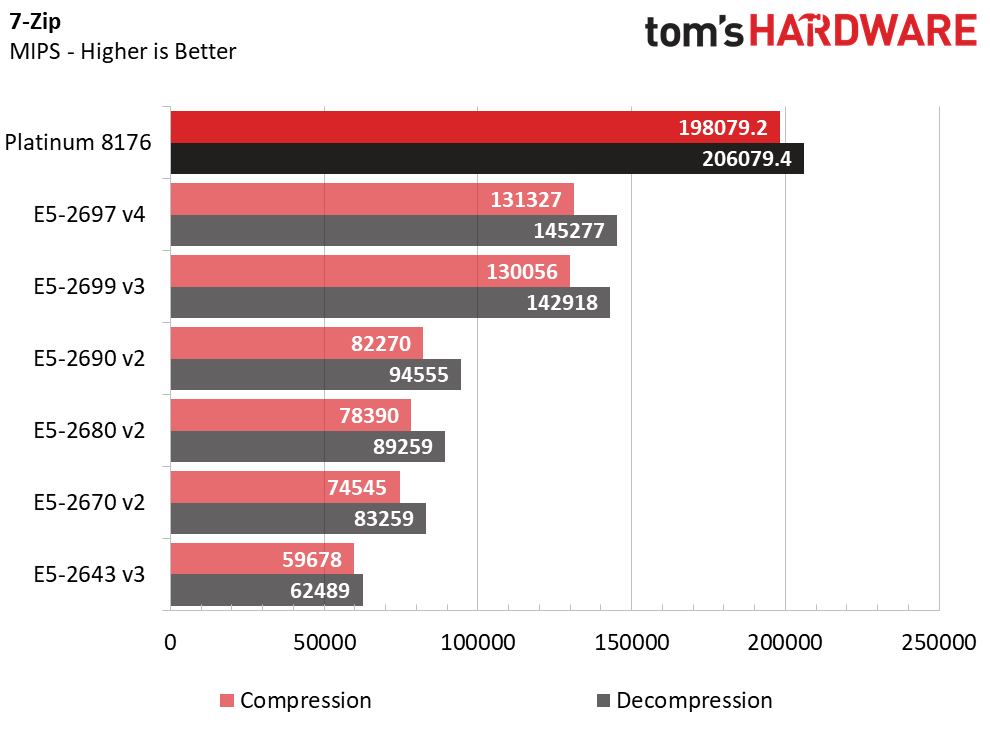Intel Xeon Platinum 8176 Scalable Processor Review
Why you can trust Tom's Hardware
Benchmarks, Part 2
Sysbench CPU
Sysbench is a widely used suite that characterizes CPU, memory, file I/O, mutex, and MySQL performance. We focus on the CPU test, which measures the amount of time required to verify prime numbers in both single- and multi-threaded workloads.
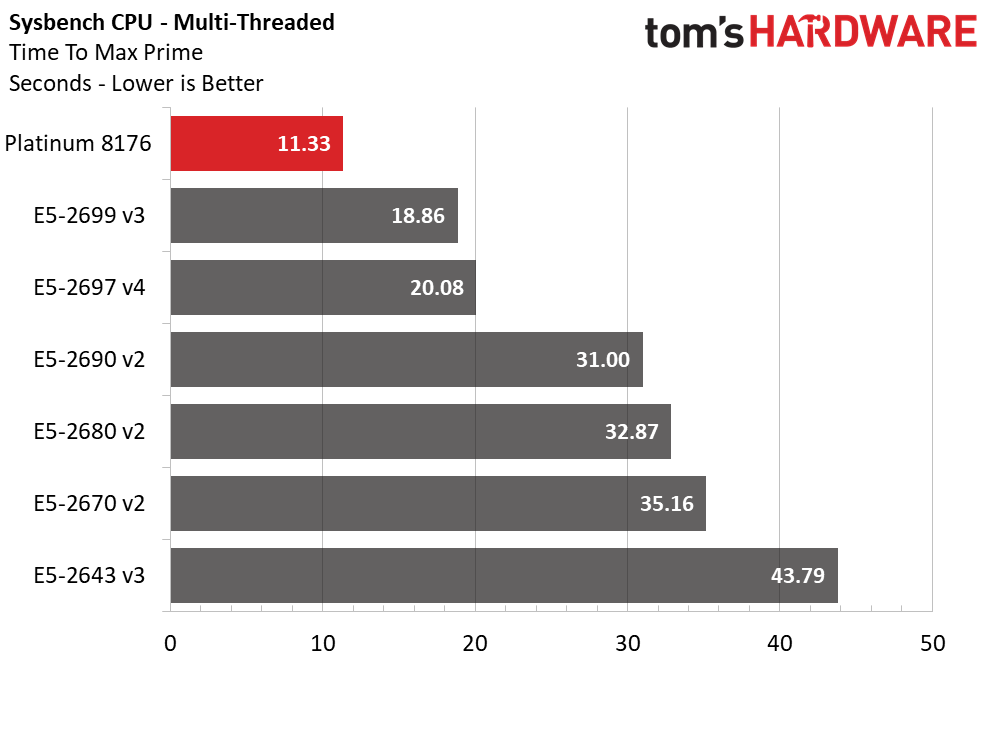
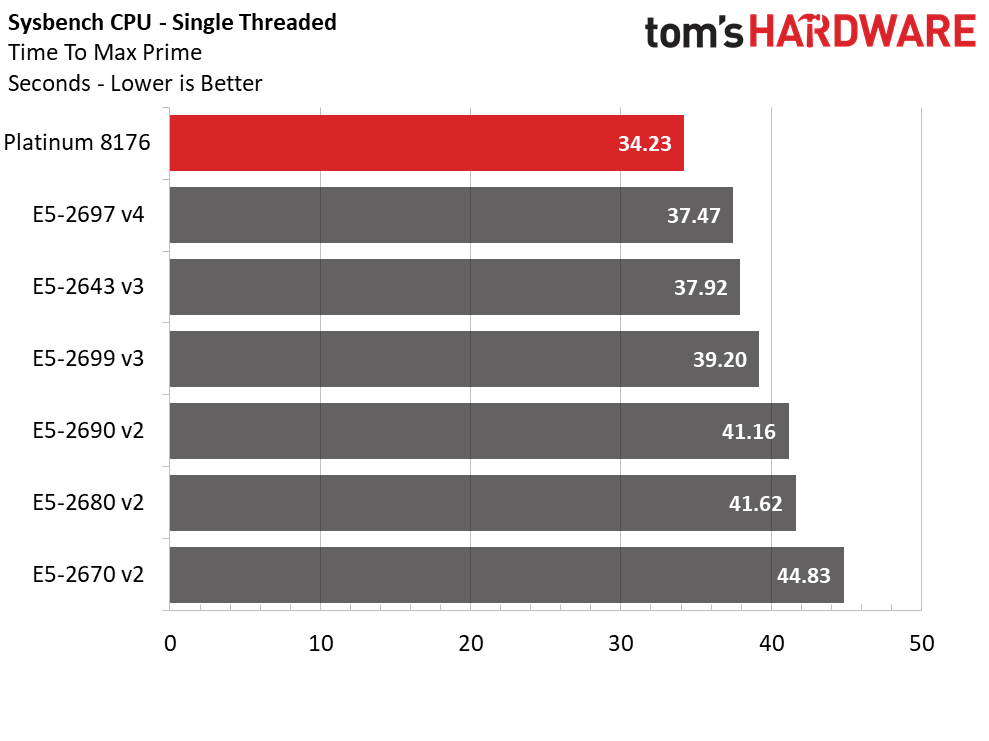
It isn't a surprise to see the Platinum 8176 take a big lead in the multi-threaded test, which highlights the gains available when you ramp up core count.
In the single-threaded test, the older platforms fall in line based on clock rate. The 8176 has a slight Turbo Boost advantage over the other contenders, which helps boost performance in lightly threaded tasks.
Stream
Stream is a relatively simple test developed by Dr. John D. McCalpin. It measures the sustainable memory throughput of a given system in MB/s.
The memory tests reveal an astounding throughput advantage favoring Intel's Platinum 8176. The combination of more memory channels at a higher data rate enables amazing results. That level of throughput, along with increased memory capacity, will enable big performance advantages in RAM-bound workloads, such as in-memory databases.
C-Ray 1.1
C-Ray is a ray tracing benchmark designed to reside entirely inside of a CPU's cache, thus eliminating RAM and disk I/O overhead during the measurement window. The test focuses purely on floating-point performance during rendering, and it runs on multiple threads.
The ray tracing workload scales nicely based on core count. Clock rate clearly plays a role too, but the Platinum 8176 primarily leverages its multi-threaded advantage to take a large lead.
Get Tom's Hardware's best news and in-depth reviews, straight to your inbox.
Most ray tracing applications require copious amounts of system memory, which pins this type of workload to CPUs more than graphics hardware. Thus, the Platinum series' support for up to 1.5TB of DDR4-2666 is a boon indeed.
7-Zip
7-Zip is open source software that measures compression and decompression performance, which can be a key capability for storage and networking applications.
As service contracts expire, most enterprises will move up from older Ivy Bridge, Haswell, and Broadwell platforms to the Platinum series. This convincing set of benchmarks highlights yet another aspect of day-to-day operations that will experience boosted performance.
HardInfo
HardInfo provides granular system information, and includes a suite of benchmarks that measure CPU performance. It's easily accessible and comes as a standard component in many Ubuntu desktop systems. We include these tests because they allow our Linux brethren to easily run comparison data.
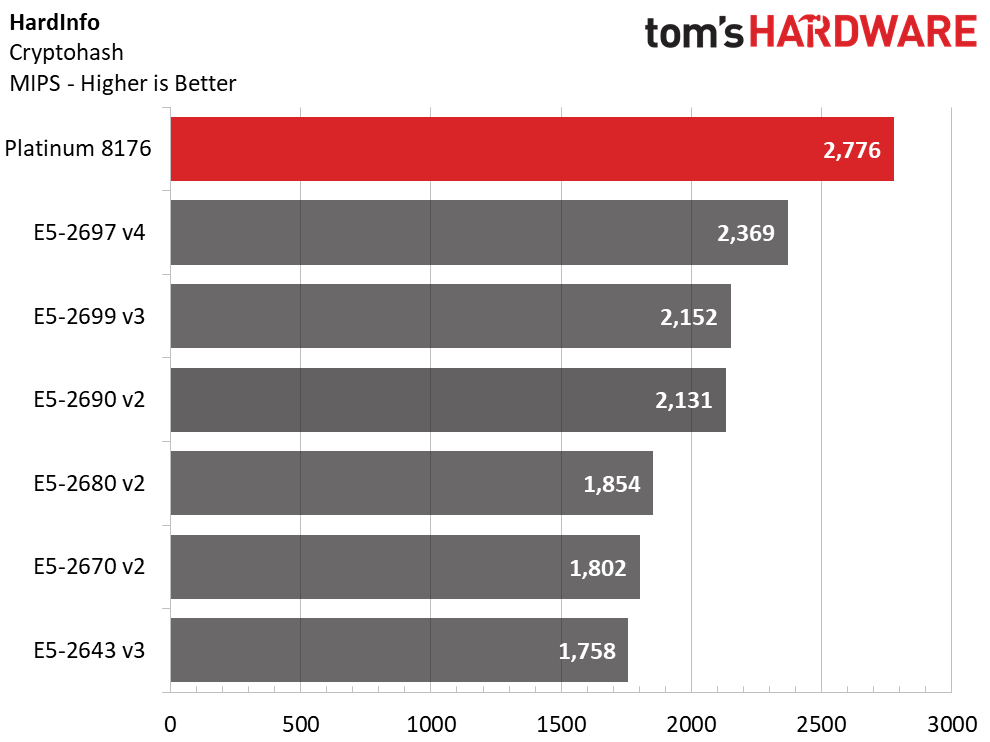
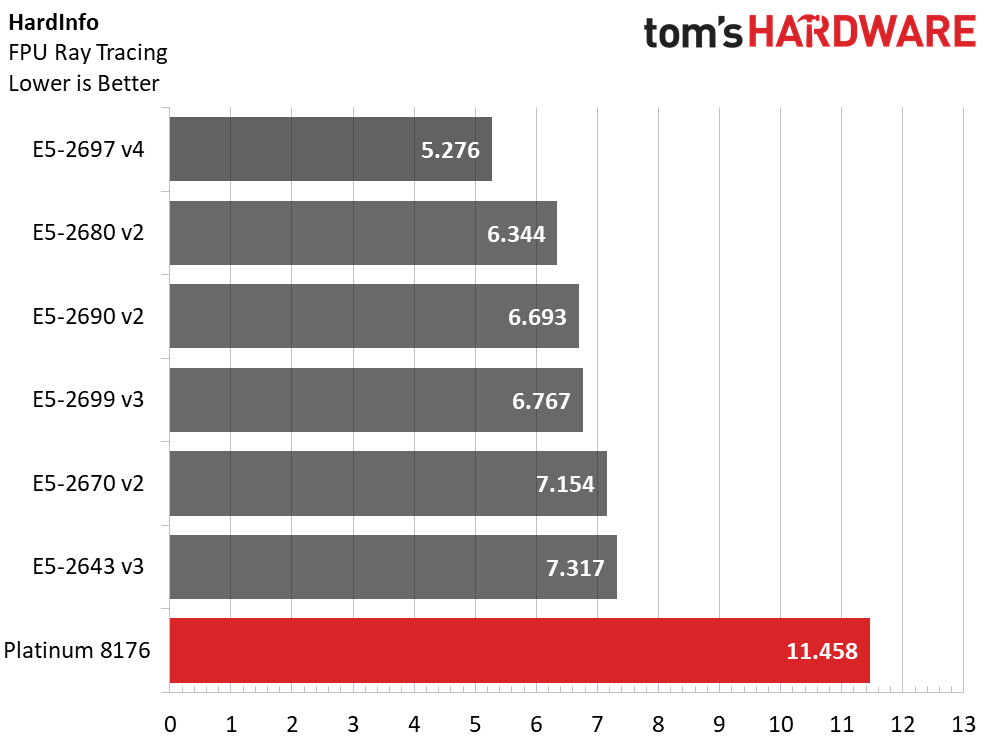
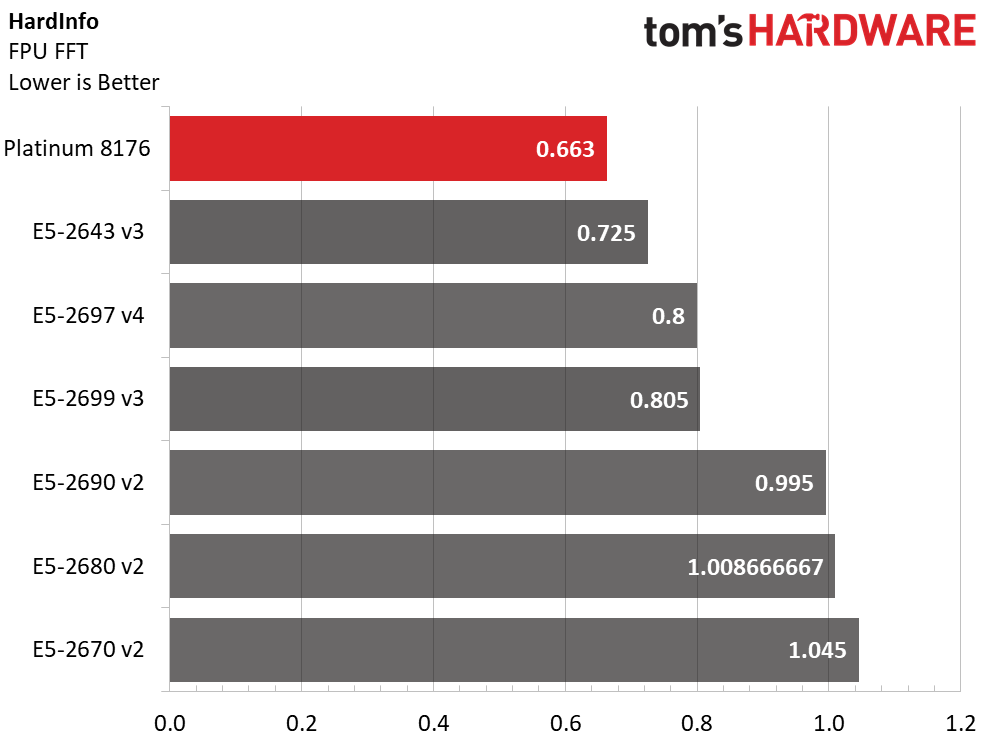

Overall, the Platinum 8176 performs to our expectations, with the notable exception of the FPU ray tracing benchmark. Intel informs us that some applications will suffer mesh-imposed performance penalties until the software ecosystem adjusts, but we've only found the altered architecture to affect a few enterprise-class benchmarks. We suspect we can add this specific title to the list of applications that might see better performance after optimizations.
MORE: Best CPUs
MORE: Intel & AMD Processor Hierarchy
MORE: All CPU Content

Paul Alcorn is the Editor-in-Chief for Tom's Hardware US. He also writes news and reviews on CPUs, storage, and enterprise hardware.
-
the nerd 389 Do these CPUs have the same thermal issues as the i9 series?Reply
I know these aren't going to be overclocked, but the additional CPU temps introduce a number of non-trivial engineering challenges that would result in significant reliability issues if not taken into account.
Specifically, as thermal resistance to the heatsink increases, the thermal resistance to the motherboard drops with the larger socket and more pins. This means more heat will be dumped into the motherboard's traces. That could raise the temperatures of surrounding components to a point that reliability is compromised. This is the case with the Core i9 CPUs.
See the comments here for the numbers:
http://www.tomshardware.com/forum/id-3464475/skylake-mess-explored-thermal-paste-runaway-power.html -
Snipergod87 Reply19926080 said:Do these CPUs have the same thermal issues as the i9 series?
I know these aren't going to be overclocked, but the additional CPU temps introduce a number of non-trivial engineering challenges that would result in significant reliability issues if not taken into account.
Specifically, as thermal resistance to the heatsink increases, the thermal resistance to the motherboard drops with the larger socket and more pins. This means more heat will be dumped into the motherboard's traces. That could raise the temperatures of surrounding components to a point that reliability is compromised. This is the case with the Core i9 CPUs.
See the comments here for the numbers:
http://www.tomshardware.com/forum/id-3464475/skylake-mess-explored-thermal-paste-runaway-power.html
Wouldn't be surprised if they did but also wouldn't be surprised in Intel used solder on these. Also it is important to note that server have much more airflow than your standard desktop, enabling better cooling all around, from the CPU to the VRM's. Server boards are designed for cooling as well and not aesthetics and stylish heat sink designs -
InvalidError Reply
That heat has to go from the die, through solder balls, the multi-layer CPU carrier substrate, those tiny contact fingers and finally, solder joints on the PCB. The thermal resistance from die to motherboard will still be over an order of magnitude worse than from the die to heatsink, which is less than what the VRM phases are sinking into the motherboard's power and ground planes. I wouldn't worry about it.19926080 said:the thermal resistance to the motherboard drops with the larger socket and more pins. This means more heat will be dumped into the motherboard's traces.
-
bit_user ReplyThe 28C/56T Platinum 8176 sells for no less than $8719
Actually, the big customers don't pay that much, but still... For that, it had better be made of platinum!
That's $311.39 per core!
The otherwise identical CPU jumps to a whopping $11722, if you want to equip it with up to 1.5 TB of RAM instead of only 768 GB.
Source: http://ark.intel.com/products/120508/Intel-Xeon-Platinum-8176-Processor-38_5M-Cache-2_10-GHz -
Kennyy Evony jowen3400 21 minutes agoReply
Can this run Crysis?
Jowen, did you just come up to a Ferrari and ask if it has a hitch for your grandma's trailer? -
bit_user Reply
I wouldn't trust a $8k server CPU I got for $100. I guess if they're legit pulls from upgrades, you could afford to go through a few @ that price to find one that works. Maybe they'd be so cheap because somebody already did cherry-pick the good ones.19927274 said:W8 on ebay\aliexpress for $100
Still, has anyone had any luck on such heavily-discounted server CPUs? Let's limit to Sandybridge or newer. -
JamesSneed Reply19927188 said:The 28C/56T Platinum 8176 sells for no less than $8719
Actually, the big customers don't pay that much, but still... For that, it had better be made of platinum!
That's $311.39 per core!
The otherwise identical CPU jumps to a whopping $11722, if you want to equip it with up to 1.5 TB of RAM instead of only 768 GB.
Source: http://ark.intel.com/products/120508/Intel-Xeon-Platinum-8176-Processor-38_5M-Cache-2_10-GHz
That is still dirt cheap for a high end server. An Oracle EE database license is going to be 200K+ on a server like this one. This is nothing in the grand scheme of things.
-
bit_user Reply
A lot of people don't have such high software costs. In many cases, the software is mostly home-grown and open source (or like 100%, if you're Google).19927866 said:An Oracle EE database license is going to be 200K+ on a server like this one. This is nothing in the grand scheme of things.


